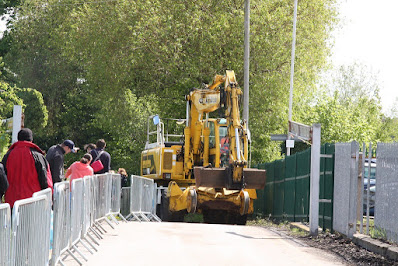 |
| Our Liverpool Echo Environment Award |
 |
| The JCB arriving to work on the railway on the same day as the 2019 Open Day |
 |
| The Butterfly Park team receiving the Liverpool Echo Environment Award |
 |
| The new display board outside the Butterfly Park |
 |
| Our Liverpool Echo Environment Award |
 |
| The JCB arriving to work on the railway on the same day as the 2019 Open Day |
 |
| The Butterfly Park team receiving the Liverpool Echo Environment Award |
 |
| The new display board outside the Butterfly Park |
 |
| Natterjack toad |
Red Rocks Marsh is a Cheshire Wildlife Trust coastal reserve covering 4 hectares of sand dunes, reedbeds and marsh. The reserve lies within the Red Rocks SSSI (Site of Special Scientific Interest). Open pools support the rare natterjack toad and this is the only breeding colony of natterjack toads in Wirral. This species is extremely limited in Britain and is protected by the 1975 Wild Creatures and Wild Plants Act.

Red Rocks Nature Reserve information board
 |
| Aerial view of Red Rocks Nature Reserve |
RECORD recently published an interesting
article about the genetics of this natterjack population and a population at Talacre.
We have reproduced this below.
Microsatellite Markers Reveal Inbreeding In Reintroduced Natterjack Toad Populations
By Susie Phillips
 |
| Natterjack toad |
Our latest article is by Susie Phillips, RECORD volunteer and Democracy & Insight Coordinator at the University of Chester. She tells us about her Masters research into Natterjack toads, which included studying a re-introduced population of this charismatic species on the Wirral.
The Natterjack toad (Epidelea calamita) (below left) is distinctive not only in its prominent dorsal stripe and loud nocturnal mating call, but also in its rarity, being found at only a handful of isolated sites in South East England, North West England, East Anglia, North Wales and parts of Scotland.
Following several local extinction events in the 1900s, the Natterjack and its breeding sites were legally protected and a series of reintroduction programmes, using individuals from extant populations alongside various habitat management techniques, took place across the UK in the 1990s. In the north west, spawn strings were taken from Ainsdale, Merseyside (a recognised stronghold for the species) to repopulate both Red Rocks Nature Reserve on the Wirral and Gronant Dunes/Talacre Warren in North Wales, both Sites of Special Scientific Interest within the Dee catchment area.
Following the reintroduction, breeding success was recorded annually by site managers via spawn string counts during the breeding season (April – July). Over the last 20 years, these counts showed interesting fluctuations in population size at both Red Rocks and Talacre but identifying population trends from demographic data alone can be misleading. Therefore, our study aimed to conduct the first genetic analysis of these populations in order to shed light on the genetic diversity of the two reintroduced populations, and to identify any potential conservation actions required to ensure the genetic longevity of the species at these sites.
 |
| Collecting natterjack toads for swabbing |
Adults were sampled using a non-invasive swabbing technique and nine microsatellite markers (short segments of DNA where the nucleotide sequence repeats) were amplified across the samples to assess genetic variation within each site and for comparison with the Ainsdale source population. We observed a high inbreeding coefficient at both sites, which indicates that individuals within the two populations were more related than would be expected where random mating occurs.
When paired with the observed level of genetic variability (heterozygosity), which is currently lower in the reintroduction sites than it was in the source population at the time of the reintroductions, this indicates that genetic diversity is low in both populations. Indeed, such low genetic diversity has not previously been recorded in any Natterjack population.
Without intervention the two populations are at higher risk of reduced fitness, increased vulnerability to disease and, ultimately, a second extinction event. However, genetic rescue via introducing new breeding individuals to the population and increasing the available breeding habitat via pool creation has been shown to effectively increase genetic diversity within this species. Therefore, with this knowledge, site managers have the opportunity to mitigate for these risks sooner rather than later and safeguard the species at these sites into the future.
You can read the full scientific paper here (open access).
Wirral Wildlife is a branch of the Cheshire Wildlife Trust, one of the network of 47 local Wildlife Trusts protecting wildlife across the UK.
Wirral Wildlife manages local nature reserves, keeps records of wildlife, scrutinises planning applications and runs a programme of meetings and guided walks open to the public.
Our website: www.wirralwildlife.org.uk
and events guide: www.wirralwildlife.org.uk/events.html